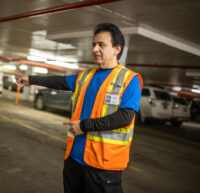The effort to build a new, earthquake-safe Sonoma Valley Hospital took various twists and turns during the past eight days.
Hospital board member John MacConaghy questioned what he called the “rather scandalous financial history” of Henry Grause, the man who initiated the proposal for Cirrus Health’s privately funded hospital on Eighth Street East.
Robert Kowal, the hospital’s chief executive officer, will keep his job – but won’t get a raise.
The Sonoma City Council decided against asking voters in June to add “hospital” along with “schools” and “parks” to the list of uses exempted from urban growth boundary restrictions – a move that could help clear the way for a publicly funded hospital on Broadway and Napa Road.
Meanwhile, hospital vice president Scott Gregerson backed away from an earlier assertion by CEO Kowal that the 17-acre Broadway site is “sewed up” and said instead that the hospital is still in negotiations with Broadway property owners.
Advocates for a newly constructed in-town hospital near the current Andrieux Street facility unveiled their proposal Monday night to a crowd of about 100 people who gathered at the Sonoma Community Center for the weekly meeting of the Sonoma Valley Health Care Coalition.
Grause’s financial history questioned
If you Google Henry Grausz, you’ll see bankruptcies and legal actions involving the Sonoma man – who now goes by the name Henry Grause – who spearheaded the effort to bring Dallas, Tex.-based Cirrus Health to build a privately funded hospital on Eighth Street East and Napa Road.
That was one point raised by John MacConaghy, a boardmember of the Sonoma Valley Health Care District, which governs the Sonoma Valley Hospital, at a special Jan. 17 meeting of the hospital board.
MacConaghy challenged Grause’s past financial dealings and distributed binders to his four fellow boardmembers containing what he said were “nothing but public records dealing with Dr. Grause’s rather scandalous financial history.”
MacConaghy said, “The idea that we would trust the public health with an individual with this financial history is dumbfounding to me.”
The history cited by MacConaghy included a 1997 judgement against Grause “in excess of $5 million” that, with interest, “is probably $10 million” now.
MacConaghy said that the financial success of the Cirrus proposal is dependent on a luxury medical spa proposed by Grause that would be built alongside the hospital on the 22-acre parcel at the northwest corner of Eighth Street East and Napa Road.
In an e-mail to the Sun that reiterated the argument he made in public, MacConaghy suggested, “Because Dr. Grausz has an outstanding $10 million judgment against him for breach of fiduciary duty, the financial viability of the Sonoma Medical Spa is in grave peril. At any time, the holder of the $10 million judgment can obtain a “Writ of Execution” and hold an involuntary “sheriff’s sale, ” i.e., a public auction similar to a foreclosure.
“This, in turn, could gravely harm the hospital operation by depriving it of this income.”
Grause was at the meeting and spoke in his own defense. He started by saying that MacConaghy had a conflict of interested because he had been the attorney for Grause’s wife in their divorce.
“He represented my wife in that dispute,” Grause said.
“Secondly, my bankruptcy is over. It’s been over since 2001.”
Grause said that MacConaghy mischaracterized Grause’s past financial dealings. He said the spelling of his last name changed to Grause because that was the spelling on his birth certificate and when he applied for a California driver’s license, “They wouldn’t give me the ‘z’.”
He also said that the cash-strapped public hospital is in serious financial straits and has several hurdles to clear if it is to survive, including convincing two-thirds of voters to support a parcel tax in March.
“Has anybody noticed? The hospital is bankrupt,” Grause said. “It’s easier to attack me than it is to deal with the reality that you’re faced with.”
“I brought (Cirrus Health) in here. I brought them in here in good faith,” Grause said. “I think I did this community a favor.”
Michael Ross, the Boyes Hot Springs architect who’s working with Cirrus Health, told the Sun this week that Grause wouldn’t be involved with the operations of the proposed Cirrus Health hospital. Grause would have a financial interest in the spa, but so would Cirrus, Ross said.
“Cirrus is going to provide the management team to run the spa,” he said.
Ross said that Grause’s attorney is going to prepare a public statement to respond to the financial issues raised by MacConaghy.
Kowal stays on at hospital
Hospital CEO Robert Kowal will continue in his job at his current rate of pay.
The Sonoma Valley Health Care District board made that decision by a 4-to-1 vote on Jan. 17 during a two-hour, closed-door, regularly scheduled review of Kowal’s performance.
The sole dissenting vote was cast by Mike Smith, a critic of Kowal who’d like to see him replaced.
The hospital board had the option of giving Kowal a pay hike.
But during public comment, audience member Lu Benson urged board members not to make any new expenditures prior to the vote in March for a five-year parcel tax of $195 per parcel to help fund the hospital’s operations.
And Kowal himself told the Sun that he wasn’t seeking a raise.
Prior to the board going into closed session, several hospital employees, including administrators and doctors, praised Kowal.
“He’s the best (CEO) I’ve worked with,” said Mark Wills, who’s been an emergency room doctor at the hospital for 18 years.
Council waits on UGB amendment
At its Jan. 17 meeting, the Sonoma City Council opted against asking voters in June to amend the urban growth boundary to add hospital to the list of exempted uses.
Cirrus Health plans to collect more than 900 signatures to hold a special election in June to ask city of Sonoma voters to amend the city’s urban growth boundary to bring the 22-acre Cirrus proposal and some 50 acres along Napa Road inside city limits.
Council decided to hold off on proposing its own ballot measure after learning there wasn’t enough time to put it on the ballot at the same time as the Cirrus proposal.
Instead, the council will wait until a preferred option for a new hospital is identified by the Sonoma Valley Health Care Coalition and the hospital board.
“I think we’re putting the cart in front of the horse,” said councilman August Sebastiani, who suggested that council “wait for the hospital board’s due diligence for the best option.”
Broadway not ‘sewed up’
Hospital CEO Robert Kowal told the Sun recently that the hospital had “sewed up” a 17-acre site on Broadway and Napa Road for a new facility.
But hospital spokesman Scott Gregerson said Tuesday that, “I think that’s a little strong. I think we’re one step before that.
“The best way I can define it is as an ongoing negotiation,” Gregerson said.
Russ Hurley, the governor of the Sonoma Moose Lodge 2048, wrote in a letter to the editor to the Sun that “the Moose Lodge is not now, nor have we ever been in negotiations to sell the property to the hospital.”
Gregerson said that the hospital made a “commitment to the (Moose) to find another suitable location” but won’t act further on it until after the coalition picks its preferred site.
In-town option unveiled
About 100 people showed up at the Sonoma Community Center Monday night to hear an evaluation of a plan to build a new Sonoma Valley Hospital inside city limits near the existing Andrieux Street facility.
Carl Gerlach of HFS Consultants reviewed the so-called in-town option at the meeting of the Sonoma Valley Health Care Coalition.
The plan calls for building a new three-story hospital on a roughly 2-acre lot on Perkins Street just north of the hospital, which now is the site of privately owned doctor’s offices that would be demolished.
The top floor of the proposed hospital would be set back, pyramid-style, to lessen the building’s visual impact.
In-town advocate Norman Gilroy said an advantage to the Perkins Street site is that it wouldn’t require the use of eminent domain. And voters wouldn’t have to expand the city’s urban growth boundary to allow hospital construction as they would for a Cirrus Health hospital proposed on Eight Street East and for a site on Broadway for a publicly financed hospital favored by hospital officials.
Strengths cited by Gerlach included the potential for positive cash flow from the facility, due to such things as a large ambulatory services, or outpatient, facility.
Weaknesses the consultant cited included limited space for expansion and less potential for a labor-efficient layout than is available at larger sites.
Sun correspondent Beau Glover contributed to this report.




